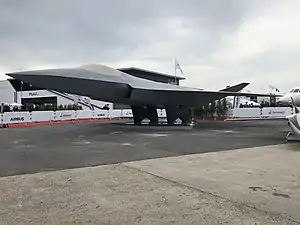Future Combat Air System
The Future Combat Air System (FCAS, French: Système de combat aérien du futur; SCAF; Spanish: Futuro Sistema Aéreo de Combate; FSAC) is a European combat system of systems under development by Airbus, Thales Group, Indra Sistemas and Dassault Aviation. The FCAS will consist of a Next-Generation Weapon System (NGWS) as well as other air assets in the future operational battlespace.[1][2] The NGWS's components will be remote carrier vehicles (swarming drones) as well as a New Generation Fighter (NGF) - a sixth-generation jet fighter[3] that by around 2035–2040 will replace current France's Rafales, Germany's Typhoons and Spain's EF-18 Hornets.[4][5]
| Future Combat Air System | |
|---|---|
.jpg.webp) | |
| Mock-up of the NGF and a remote carrier at the 2019 Paris Air Show | |
| Role | Combat system of systems |
| Manufacturer |
|
| Introduction | c. 2040 |
| Primary user |
|
| New Generation Fighter | |
|---|---|
 | |
| Mock-up of the NGF at the 2019 Paris Air Show | |
| Role | Sixth-generation jet fighter |
| National origin | France Germany Spain |
| First flight | Planned after 2025 |
| Introduction | Planned for 2040 |
| Status | Under development |
A test flight of a demonstrator is expected around 2025 and entry into service around 2040.[6][7][8][9][10][11]
Contractors
Dassault will serve as prime contractor for the NGF, while Airbus will lead the development of accompanying remote carrier vehicles and the broader system's supporting combat cloud.[12] It will also be carrier-capable and will fly from the French Navy's future aircraft carrier.[13][14][15] Safran Aircraft Engines will be the prime contractor for the next-generation fighter aircraft engine, taking the lead in engine design and integration, while MTU Aero Engines, as the main partner for the first phase of research and technology, will take the lead in engine services.[16]
Each country has designated a national industrial coordinator, Airbus for Germany, Indra for Spain and Dassault for France.[17]
History
In 2017 Germany and Spain asked Airbus to start working on a proposal for a new fighter under the name Future Combat Air System (FCAS).[18][19]
At the 2018 ILA Berlin Air Show, Dassault Aviation and Airbus announced an agreement to cooperate on the development of the FCAS.
In December 2018, the German Defence Ministry welcomed Spain's expression of interest in the programme.[20]
In June 2019 Spain joined the programme.[21]
In December 2019 Safran and MTU Aero Engines agreed on the foundation of a 50/50 joint venture that will be incorporated by the end of 2021 to manage the development, production, and the after-sales support activities of the new engine to power the NGF.[22]
On February 12, 2020, the first phase (1A) of the research and development program was approved by the German parliament budget committee. It set up the industrial distribution of the first five subprograms.[23]
Development
Phase 1A - Initial framework contract
Dassault, Airbus, together with their partners MTU Aero Engines, Safran, MBDA and Thales, were awarded the initial framework contract which launches the demonstrator phase. Beginning February 2020 it is expected to cover a period of 18 months of research and development. While it assigned different roles to the above mentioned companies, Spain was left out:[24]
- Next Generation Fighter (NGF), with Dassault Aviation as prime contractor and Airbus as main partner
- Unmanned systems Remote Carrier (RC) with Airbus as prime contractor and MBDA as main partner
- Combat Cloud (CC) with Airbus as prime contractor and Thales as main partner
- Engine with Safran and MTU Aero Engines as main partner
Phase 1B
Additional suppliers will be involved.
See also
Aircraft
References
- "Air superiority and nuclear deterrence dictate manned future fighter for France". Jane's 360.
- Pike, John. "Next Gen WS". Global security.
- Roblin, Sebastien (5 February 2019). "Forget the F-22 or Su-57: Europe Wants a Deadly 6th Generation Stealth Fighter". The National Interest. Retrieved 16 February 2019.
- Pike, John. "New Generation Fighter (NGF)". Global security.
- Trevithick, Joseph. "Eurofighter Consortium 2.0 Takes Shape As Spain Set To Join Franco-German Stealth Jet Program". The war zone. The Drive. Retrieved 16 February 2019.
- Roblin, Sebastien (4 May 2018). "Will Germany and France Develop Europe's First Stealth Fighter?". The National Interest. Retrieved 18 July 2018.
- "Airbus and Dassault Launch a New FCAS—without BAE". Aviation International News. Retrieved 18 July 2018.
- "Airbus, Dassault Join Forces on Future Combat Aircraft for Europe". Avionics. 25 April 2018. Retrieved 18 July 2018.
- "ILA: Airbus, Dassault cement FCAS pact". Flightglobal.com. 25 April 2018. Retrieved 18 July 2018.
- "Germany-France to develop Eurofighter/Rafale replacement". AviationAnalysis.net. Retrieved 18 July 2018.
- Editorial, Reuters. "Airbus, Dassault to team up for new fighter jet project". U.S. Retrieved 18 July 2018.
- "Dassault and Airbus unveil New Generation Fighter". flightglobal. Retrieved 25 June 2019.
- "Euronaval 2018: France Officially Launches Aircraft Carrier Renewal Program". Navy recognition.
- "Good and Bad News for Franco-German Fighter". AIN online.
- Dubois, Thierry (23 October 2018). "Dassault Unveils 'New-Gen' Fighter mockup". Aviation Week. Retrieved 21 November 2018.
- "Safran and MTU agree on way ahead for next-gen fighter aircraft engine". 5 December 2019.
- https://www.defensenews.com/global/europe/2019/11/26/spains-indra-claims-lead-in-eu-electronic-warfare-push-for-future-aircraft/
- https://www.defenseworld.net/news/19796/Is_The_Proposed_Airbus_Fighter_Jet_A_Non_starter_#.XtKCKZ77TUI
- https://euobserver.com/economic/138193
- "Germany, France to add Spain to fighter program: sources". Reuters. 5 December 2018. Retrieved 7 December 2018.
- "La ministra de Defensa española ha firmado en el Salón de Le Bourget la incorporación al programa FCAS por parte española" (in Spanish). fly-news.es. 17 June 2019. Retrieved 17 June 2019.
- "Safran, MTU agree framework for future fighter engine | Jane's 360". www.janes.com. Retrieved 28 April 2020.
- Charpentreau, Clement (13 February 2020). "European fighter jet demonstrator receives German greenlight". AeroTime.aero. Retrieved 14 February 2020.
- https://www.defenseworld.net/news/26382/Spanish_Indra_justifies_role_in_FCAS_Project_after_Airbus__Opposition#.XtJ6D577TUI